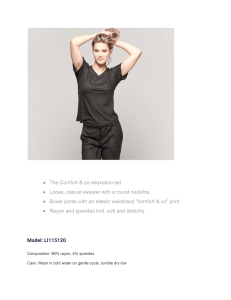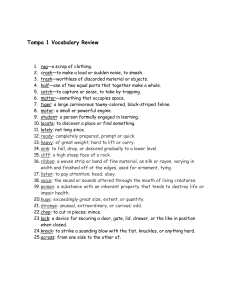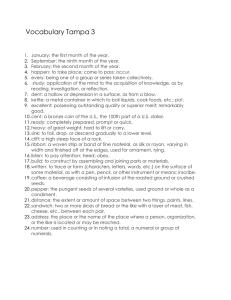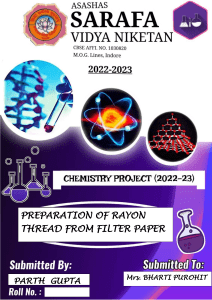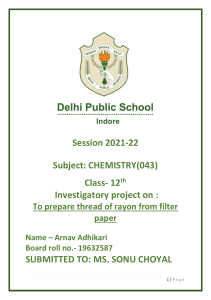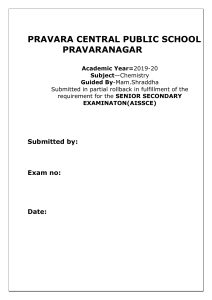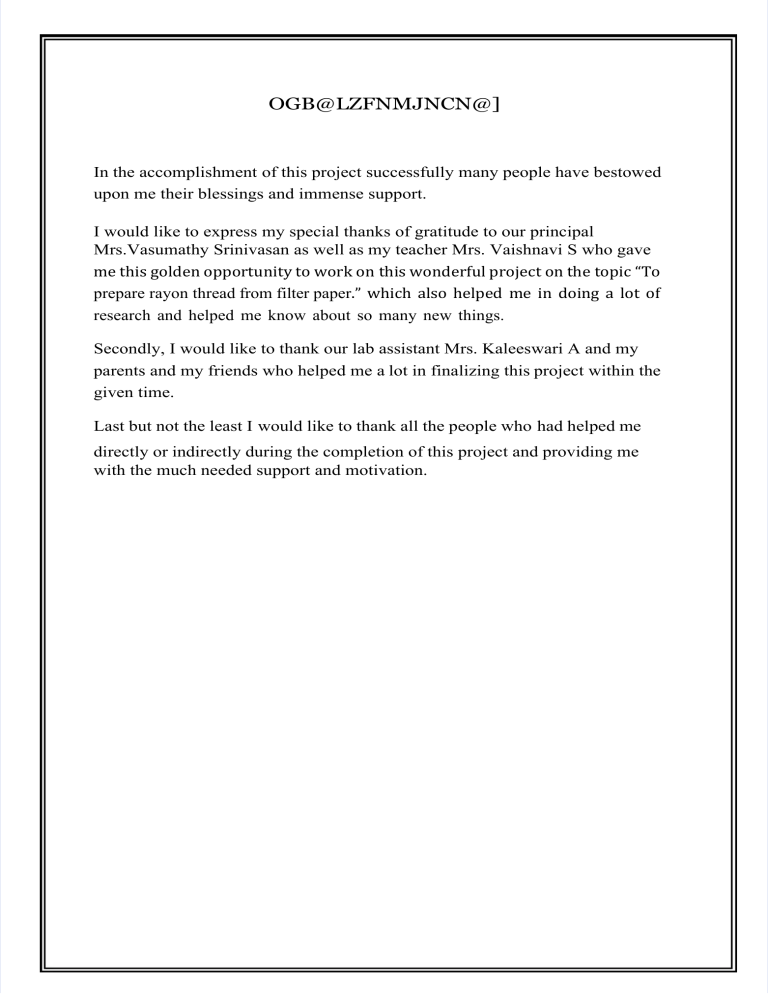
OGB@LZFNMJNCN@] In the accomplishment of this project successfully many people have bestowed upon me their blessings and immense support. I would like to express my special thanks of gratitude to our principal Mrs.Vasumathy Srinivasan as well as my teacher Mrs. Vaishnavi S who gave me this golden opportunity to work on this wonderful project on the topic “To prepare rayon thread from filter paper.” which also helped me in doing a lot of research and helped me know about so many new things. Secondly, I would like to thank our lab assistant Mrs. Kaleeswari A and my parents and my friends who helped me a lot in finalizing this project within the given time. Last but not the least I would like to thank all the people who had helped me directly or indirectly during the completion of this project and providing me with the much needed support and motivation. TABLE OF CONTENTS: S.NO TOPIC PAGE NO 01. Introduction 01 02. History 02 03. Theory 03 04. Properties & Fibre Properties Overview 04 05. Types Of Rayon 06 06. Production Method 06 07. Applications Of Rayon Thread 09 08. Experiment Aim Apparatus required Chemical reactions involved Procedure Result Precautions 10 10 10 11 11 13 13 09. Conclusion 14 10. Bibliography 15 • • • • • • INTRODUCTION: Cellulose is nature's own giant molecule. It is the fibrous material that every plant from seaweed to the sequoia make by baking glucose molecules in long chains; the chains are bound together in the fibres that gives plants their shape and strength. Wood now has become the main source of cellulose. Since it contains only 40% to 50% cellulose, substance must be extracted by ‘pulping'. The logs are flaked, and then simmered in chemicals that dissolve the tarry lignin, resins and minerals. The remaining pulp, about 93% cellulose, is dried and rolled into sheets as raw material for paper, rayon and other products. Rayon is synthetic fibre produced from cellulose. This natural base gives it many of the characteristics- low cost, diversity and comfort that have led to its popularity and success. Regardless of the manufacturing process rayon has only a single source of raw material, natural cellulose. The major sources of natural cellulose are wood pulp usually obtained from pine, spruce, or hemlock trees. It can be obtained by two commercially viable methods: 1. Viscose process: In this process cellulose is soaked in 30% caustic soda solution for about 3 hours. The alkali solution is then removed and the product is treated with CSi. This gives cellulose xanthates, which is dissolved in NaOH solution to give a viscous solution. This is filtered and forced through a spinneret into dilute solution of H2SO4, both of which harden to form gum like thread into rayon like fibres.this process of making viscose was found by C.F Cross and and E.J Bevan in 1891. 01 2. Cuprammonium rayon: In this process cupprammonium rayon is obtained by dissolving pieces of filter paper in a deep blue solution containing tetra-ammine cupric hydroxide. The latter is obtained from a solution of copper sulphate. To it ,ammonium hydroxide solution is added to precipitate cupric hydroxide, which is then dissolved in excess of NH 4 Filter paper is a quantitative paper used for filtering and made of pure cellulose treated with hydrochloric and hydrofluoric acid. This filter paper is used as a source for preparing rayon thread using cuprammonium process. HISTORY: For centuries humankind has relied upon various plants and animals to provide the raw materials for fabrics and clothing. Silkworms, sheep,beaver, buffalo deer, and even palm leaves are just some of the natural resources that have been used to meet these needs. However, in the last century scientists have turned to chemistry and technology to create and enhance many of the fabrics we now take for granted. There are two main categories of man-made fibres: those that are made from natural products and those that are synthesized solely from chemical compounds. Rayon is synthetic fibre produced from cellulose. This natural base gives it many of the characteristics- low cost, diversity and comfort that have led to its popularity and success. Developed in an attempt to produce silk chemically, it was originally called artificial silk or wool silk. Today, rayon is 0; considered to be one of the most versatile and economical man-made fibres available. It has been called as “the laboratory's first gift to the loom”. Schweizer, in 1857, published the first paper dealing with the discovery that an ammoniacal solution of cupric oxide would dissolve cellulose. This solution is commonly known in the literature as Schweitzer's reagent, E. A. Parnefl, in "Life and Labors of John Mercer", states: "Mercer appears to have been the first to notice the remarkable action which the ammoniacal solution of cupric oxide exerts on cotton fibre". The solubility of cellulose in cuprammonium was first utilized by the Bereinigte Glanzstoff-Fabriken A. G. of Elberfleld, for the production of rayon. This was one of the earliest methods of producing rayon. In the 1860's the French silk industry was being threatened by a disease affecting the silkworm. Louis Pasteur and Count Hilaire de Chardonnet were studying this problem with the hope of saving this vital industry. During this crisis, Chardonnet became interested in the production of artificial silk. In 1885 he patented the first successful process to produce a useable fibre from cellulose. Even though other scientists have subsequently developed more costeffective ways of making artificial silk. Chardonnet is still considered as the father of rayon. For the next 40 years years this was called artificial or imitation silk. By 1925 it had developed into an industry onto itself and was given the name rayon by the federal trade commission. The term rayon at this time was used to indicate any man made fibre made from cellulose at this time. Today rayon is one of the most widely used fabrics in our society. It is made in countries across the world. It can be blended with natural or man made fabrics, treated with enhancements and also made to perform a variety of functions. THEORY: Of all the fibres, rayon is probably the most perplexing to consumers. It can be found in cotton like end uses, as well as sumptuous velvets and taffetas. It may function successfully in absorbent and in well absorbent hygiene and incontinence pads and equally well providing strength in tire conds. R reodstfim braen.m Tahdeetefrim ffoictiaslyln yth ad byaythoen tw exatsilteheinfdirustrm ya.n uu nfliakcetum brreasy,oranyw onasison etoipct.eidts 07 is made from wood pulp, a naturally occurring, cellulose based raw material. As a result, rayon properties are more similar to those of natural cellulose fibres, such as cotton or linen, than those of thermoplastic, petroleum based synthetic fibres, such as nylon or polyester. Although rayon is made from wood pulp, a relatively inexpensive and renewable resource, processing requires high water and energy use, and has contributed to air and water pollution. Modernization of manufacturing plants and combined with availability of raw material has increased rayon's competitiveness in the market. PROPERTIES: Viscose rayon has a silk like aesthetic with superb drape and feel and retains its rich and brilliant colours. Its cellulosic base contributes to many properties similar to those of cotton or other natural cellulosic fibres. Rayon is a moisture absorbent, breathable, comfortable to wear, and easily died in vivid colours. It does not build up static electricity, nor will it pill unless the fabric is made from short, low-twist yarns. Regular rayon has lengthwise lines called striations and its cross-section is an indented circular shape. The cross-sections of HWM and cupra rayon are rounder. Filament rayon yarns vary from 80 to 980 filaments per yarn and vary in size from 40 to 5000 denier. Staple fibres range from 1.5 to 15 denier and are mechanically or chemically crimped. Rayon fibres are naturally very bright, but the addition of delustering pigments cuts down on this natural brightness. Rayon is comfortable, soft to skin and has moderate dry strength and abrasion resistance. Like other cellulosic fibres, it is not resilient, which means that it will wrinkle with ease. Rayon withstands ironing temperatures slightly less than 04 that of cotton. It may be attacked by silverfish or termites, but generally resist insect damage. One of rayon's strength is its versatility and ability to blend easily with many fibres, sometimes to reduce cost, other times for lustre, softness, or absorbancy and resulting comfort. Rayon has moderate resistance to acids and alkalis and generally the fibre itself is not damaged by bleaches; however dyes used in the fabric may experience colour change. As a cellulosic fibre rayon will burn but flame retardant finishes maybe applied. High wet modulus rayon (HWM) is a modified version of viscose that is stronger when wet. It also has the ability to be mercerized like cotton. HWM rayons are also known as "polynosic." Polynosic fibers are dimensionally stable, and do not shrink or get pulled out of shape when wet like many rayons. They are also wear resistant and strong while maintaining a soft, silky feel. They are sometimes identified by the trade name Modal. High-tenacity rayon is another modified version of viscose that has almost twice the strength of HWM. This type of rayon is typically used for industrial purposes such as tire cord. FIBRE PROPERTIES OVERVIEZ: • • Rayon as cloth is soft and comfortable. it drapes well, which is one of the reasons it is so desirable as an apparel fabric. It is the most absorbent of all cellulose fibres, even more so than cotton and linen. Because of this , rayon absorbs perspiration and allow it to evaporate away from the skin, making it an excellent summer fabric. 0> • • • • It loses a great deal of strength when wet. Because of this, it stretches and shrinks more than cotton. Poor due to inelasticity of the fibres. It is easily damages by scraping and will pill on the surface of the cloth. Because of its excessive flammability, it inspired the flammable fabrics act. The FFA was enacted by the U.S . department of commerce in 1953in response to public concern over a number of serious burn accidents involving brushed rayon high pile sweaters and children cowboy chaps which could easily catch fire and flash burn. No static build up. TYPES OF RAYON FIBRES: Joyce Smith in her paper on rayon for Ohio State University Extension, identifies 4 major types of modifications of Rayon. These are: Regular or (Viscose) Rayon HWM ‗ High Wet Modulus Rayon ‗ ‘Codal' rayon High Tenacity Rayon ‗ mainly industrial uses ‗ like cords and in tires Cupramonium Rayon. • • • • PRODUCTION METHOD: Regular rayon (or viscose) is the most widely produced form of rayon. This method of rayon production has been used since the early 1900s and it has the ability to produce either filament or staple fibres. The process is as follows: The steps involved in commercial manufacture of rayon in industries can be summarized broadly into the following: 08 1. Cellulose: Production begins with processed cellulose (obtained from wood pulp and plant fibers). The cellulose content in the pulp should be around 87% to 97%. 2. Immersion: The cellulose is dissolved in caustic soda: (C6H10O5)n + n@aOA ↛ (C6H9O4ONa)n + nH2O is the chemical reaction. The reaction converts cellulose to alkali cellulose and removes impurities. 3. Pressing: The solution is then pressed between rollers to remove excess liquid. The pressing is done in accordance with the press-weight ratio. Press weight ratio is the ratio between the pressed alkali cellulose sheet weight to the weight of air dried pulp. It is adjusted to 2.7-3. 4. "White Crumb": The pressed sheets are crumbled or shredded to produce what is known as "white crumb." 5. Ageing: The "white crumb" is aged through exposure to oxygen. This is a depolymerization step and is avoided in case of polynosics. 6. "Xanthation": The aged "white crumb" is mixed with carbon disulfide in a process known as "Xanthation," in which the aged alkali cellulose crumbs are placed in vats and are allowed to react with carbon disulfide under controlled temperature (20 to 30 °C) to form cellulose xanthate: 7. "Orange-Yellow Crumb": The Xanthation changes the chemical makeup of the cellulose mixture, and the resulting product is now called "yellow crumb." This orange coloration is due to the formation of sodium trithiocarbonate (Na2CS3). 07 8. Viscose: The "yellow crumb" is dissolved in a caustic solution to form viscose. 9. Ripening: The viscose is set to stand for a period of time, allowing it to ripen: (C6H9O4O∛WC∛W@a)n + nH2O ↛ (C6H10O5)n + nCS2 + nNaOH is the reaction. 10. Filtering: After ripening, the viscose is filtered to remove any undissolved particles. 11. Degassing: Any bubbles of air are pressed from the viscose in a degassing process. 12. Extruding: The viscose solution is extruded through a spinneret, which resembles a shower head with many small holes. 13. Acid Bath: As the viscose exits the spinneret, it lands in a bath of sulfuric acid, resulting in the formation of rayon filaments. The acid is used as a regenerating agent. It converts cellulose xanthate back to cellulose. The regeneration step is rapid which doesn't allow proper orientation of cellulose molecules. So to delay the process of regeneration, zinc sulphate is used in the bath which converts cellulose xanthate to zinc cellulose xanthate thus providing time for proper orientation to take place before regeneration. 14. Spinning: The spinning of viscose rayon fibre is done using a wet spinning process. The filaments are allowed to pass through a coagulation bath after extrusion from the spinneret holes. Two-way mass transfer takes place. 01 15. Drawing: The rayon filaments are stretched, in a procedure known as drawing, to straighten out the fibres. 16. Washing: The fibres are then washed to remove any residual chemicals from them. 17. Cutting: If filament fibres are desired, then the process ends here. The filaments are cut down when producing staple fibres. APPLICATIONS OF RAYON FIBRES: • • • • Rayon typically has an elevated luster quality giving it a brilliant gloss Mainly, Rayon fibres are used in apparel industry such as Aloha shirts, blouses, dresses, Jackets, Lingerie, scarves, suits, ties, hats and socks. Some rayon fibres are for filling in Zippo lighters, furnishings including bedspreads, bedsheets, blankets, window covers, upholstery and slipcovers. For industrial purposes such as medical surgery products, nonwoven h ityeg mies,nteirpero codrudctasn. d some other uses like diapers, towels, feminine 05 EXPERIMENT: AIM: The main objective of the project is to prepare rayon thread from cuprammonium process. Instead of using wood pulp as the cellulose source, attempt is done to make use of raw cellulose products such as filter paper. REQUIREMENTS: Beakers, conical flasks, filtration flasks, vacuum pump, bent tube, glass rod, 50% ammonia solution, dil. NaOH solution, dil. H 2SO4, filter paper, or waste paper. 10 CHEMICAL RECTIONS INVLOVED: Dilute NaOH solution is added to a solution of copper sulphate solution to form a precipitate of Cu(OH)2. CuSO4 + 2NaOH →Cu(OH)2 + Na2SO4 The precipitate is transferred into a beaker containing liquor ammonia resulting in the formation of a deep blue solution of cuprammonium hydroxide. Cu(OH)2+ 4NH4OH → [Cu(NH3)4](OH)2+ 4H2O Dissolving filter paper in cuprammonium hydroxide solution leave out a viscous solution called viscose. PROCEDURE: The cellulose is dissolved in cuprammonium hydroxide [Cu(NH3)4](OH)2 and the procedure to be followed is given below. 1. To prepare cuprammonium hydroxide solution: Weigh about 20.0 g of crystalline copper sulphate in a clean watch glass. Dissolve it in 100 ml of water taken in a beaker. Add dilute NaOH solution to this solution slowly with stirring and note the separation of precipitate of Cu(OH)2. Filter the precipitate on water pump and wash the precipitate thoroughly with water so that a portion of filtrate does not indicate presence of sulphate ions on testing with BaCl2 solution. Now transfer the precipitate to a 250 ml beaker add 50 ml of liquor ammonia. The precipitate will dissolve resulting in a deep blue solution of cuprammonium hydroxide (Schweitzer's solution). This is the solvent for dissolving cellulose. 2. Dissolving the cellulose matter:Weigh about 1 g of ordinary filter paper and cut it into small pieces. Add these pieces to the cuprammonium solution taken in a conical flask. Close the flask with rubber stopper and allow it to stand for 3-4 days. In this time, filter paper completely dissolves leaving a viscous solution called viscose. 11 3. Formation of rayon filament: The viscose solution is taken in a syringe. Then the nozzle of the syringe is dipped in a 5M H 2SO4 solution taken in a wide mouthed beaker. Squeeze out the viscous into the acid solution and at the same time keep on moving the nozzle in the acid. Long filaments of rayon will be formed in the beaker. The acid bath is left undisturbed for 24 hours, until the blue colour of rayon filament changes to white. Rayon filaments are then removed from the acid bath, washed with water and dried by keeping them on filter paper. When the threads are completely dried, weigh them and determine the maximum length of the fibre formed. 12 RESULTS: Thus we successfully prepare rayon thread using filter papers. The results show here that the rayon threads thus formed are used only for the sole purpose of sampling. PRECAUTIONS: 1. Addition of excess of liquor of ammonia should be avoided. 2. Before taking the viscose into the syringe, make sure that it doesn't have any pieces of paper otherwise the bits of paper tend to clog the needle of the syringe. 3. Addition of liquor ammonia should be performed in a fume cupboard with extra care otherwise the fumes if inhaled cause heavy giddiness. 4. Prefer using a thick needle otherwise the fibres wont come out with preffered thickness and quality. 13 CONCLUSION The cuprammonium method of producing rayon is a convenient method to produce rayon threads. Rayon being the most commonly used thread in the embroidery industry, is relatively inexpensive and has a beautiful sheen. The answer is because rayon is weak and not colourfast. It is not the recommended quality fibre for quilting or embroidery. Because rayon is manufactured from naturally occurring polymers, it is considered a semi-synthetic fibre. Specific of rayon includes viscose, modal and lyocell, each of which differs in manufacturing process and the properties of finished products. 14 BIBLIOJRAPHY 1. https://en.wikipedia.org/wiki/Rayon 2. https://www.slideshare.net 3. https://www.icbse.com/projects 4. https://thechemistryguru.com 5. https://cbseportal.com/Projects/Download-CBSE-Class-XII-Chemistry 6. https://www.academia.edu 7. http://www.allprojectreports.com 8. https://en.wikipedia.org 9. https://simple.wikipedia.org 10.https://www.britannica.com/technology 15
